You need to connect Vnet2 and Vnet3. The solution must meet the virtual networking requirements and the business requirements.
Which two actions should you include in the solution? Each correct answer presents part of the solution.
NOTE: Each correct selection is worth one point.
You need to implement a P2S VPN for the users in the branch office. The solution must meet the hybrid networking requirements.
What should you do? To answer, select the appropriate options in the answer area.
NOTE: Each correct selection is worth one point.

You need to provide connectivity to storage1. The solution must meet the PaaS networking requirements and the business requirements.
What should you include in the solution?
You need to configure the default route in Vnet2 and Vnet3. The solution must meet the virtual networking requirements.
What should you use to configure the default route?
You need to restrict traffic from VMScaleSet1 to VMScaleSet2. The solution must meet the virtual networking requirements.
What is the minimum number of custom NSG rules and NSG assignments required? To answer, select the appropriate options in the answer area.
NOTE: Each correct selection is worth one point.
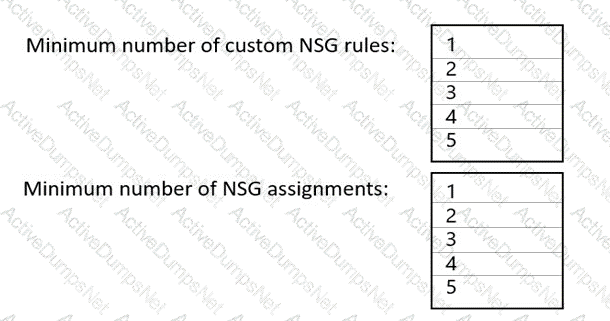
You need to implement name resolution for the cloud.liwareinc.com. The solution must meet the networking requirements.
What should you do? To answer, select the appropriate options in the answer area.
NOTE: Each correct selection is worth one point.

You need to recommend a configuration for the ExpressRoute connection from the Boston datacenter. The solution must meet the hybrid networking requirements and business requirements.
What should you recommend? To answer, select the appropriate options in the answer area.
NOTE: Each correct selection is worth one point.

You need to provide access to storage2. The solution must meet the PaaS networking requirements and the business requirements.
Which connectivity method should you use?
You need to implement outbound connectivity for VMScaleSet1. The solution must meet the virtual networking requirements and the business requirements.
Which three actions should you perform in sequence? To answer, move the appropriate actions from the list of actions to the answer area and arrange them in the correct order.
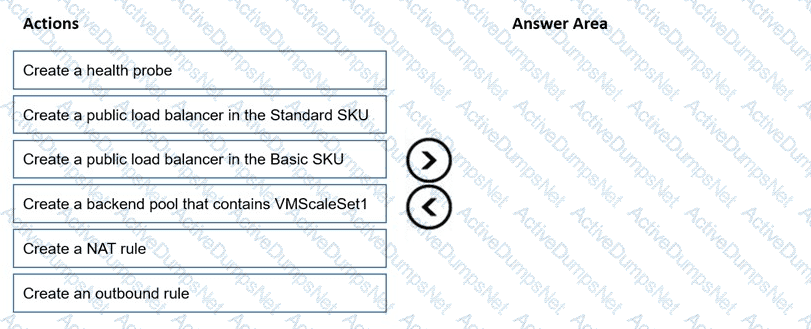
You need to configure the default route in Vnet2 and Vnet3. The solution must meet the virtual networking requirements.
What should you use to configure the default route?
You need to implement outbound connectivity for VMScaleSet1. The solution must meet the virtual networking requirements and the business requirements.
Which three actions should you perform in sequence? To answer, move the appropriate actions from the list of actions to the answer area and arrange them in the correct order.

You have an Azure virtual network that contains a subnet named Subnet1. Subnet1 is associated to a network security group (NSG) named NSG1. NSG1 blocks all outbound traffic that is not allowed explicitly.
Subnet1 contains virtual machines that must communicate with the Azure Cosmos DB service.
You need to create an outbound security rule in NSG1 to enable the virtual machines to connect to Azure Cosmos DB.
What should you include in the solution?
Your company has 40 branch offices that are linked by using a Software-Defined Wide Area Network (SD-WAN). The SD-WAN uses
BGP.
You have an Azure subscription that contains 20 virtual networks configured as a hub and spoke topology. The topology contains a hub virtual network named Vnetl.
The virtual networks connect to the SD-WAN by using a network virtual appliance (NVA) in Vnetl.
You need to ensure that BGP route advertisements will propagate between the virtual networks and the SD-WAN. The solution must minimize administrative effort
What should you implement?
You have an Azure subscription that contains an instance of Azure Firewall Standard named AzFW1. You plan to enable the following:
• TLS inspection
• Threat intelligence
• A network intrusion detection and prevention system (IDPS)
What can you enable by using AzFW1?
You have an Azure subscription that contains the virtual networks shown in the following table.
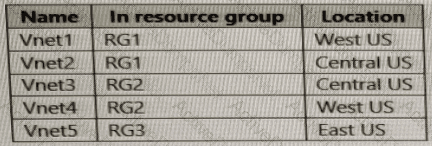
You plan to deploy an Azure firewall named AF1 to RG1 in the West US Azure region.
To which virtual networks can you deploy AF1?
You have an Azure application gateway.
You need to create a rewrite rule that will remove the origin port from the HTTP header of incoming requests that are being forwarded to the backend pool.
How should you configure each setting? To answer, select the appropriate options in the answer area.
NOTE: Each correct selection is worth one point.
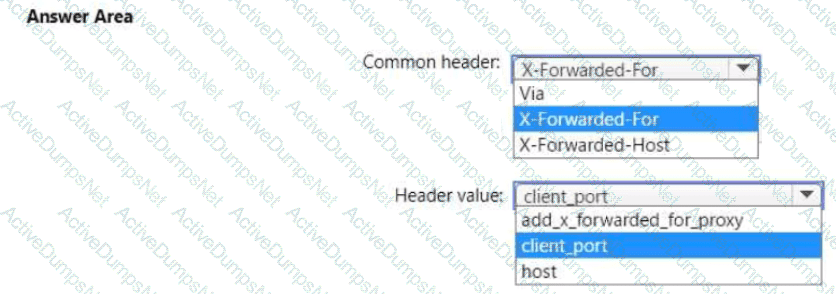
You have an internal Basic Azure Load Balancer named LB1 That has two frontend IP addresses. The backend pool of LB1 contains two Azure virtual machines named VM1 and VM2.
You need to configure the rules on LB1 as shown in the following table.

What should you do for each rule?
You have the on-premises networks shown in the following table.

You have an Azure subscription that contains an Azure virtual WAN named VWAN1 and a virtual network named VNet1 VWAN1 is connected to the on-premises networks and VNet1 in a full mesh topology. The virtual hub routing preference for VWAN1 is AS Path.
You need to route traffic from VNet1 to 10.61.1.5.
Which path will be used?
You have an on-premises network.
You have an Azure subscription that contains the resources shown in the following table.

You need to implement an ExpressRoute circuit to access the resources in the subscription. The solution must ensure that the on-premises network connects to the Azure resources by using the ExpressRoute circuit.
Which type of peering should you use for each connection? To answer, select the appropriate options in the answer area.
NOTE: Each correct selection is worth one point.

You need to configure APPGW1 to support end-to-end encryption. The solution must meet the security requirements. What should you do?
You need to plan the deployment of LBGW1. The solution must support the planned changes.
What should you include in the solution? To answer, select the appropriate options in the answer area.
NOTE: Each correct selection is worth one point.

You need to configure the P2S VPN to meet the connectivity requirements.
What should you do? To answer, select the appropriate options in the answer area.
NOTE: Each correct selection is worth one point.

You ate configuring the DNS forwarding luleset for DNSR1
You need to configure the destination IP address for azure.proseware.com and for corp.proseware.com. The solution must meet the general requirements.
Which IP addiesses should you configure for each namespace? To answer, select the appropriate options in the answer area.
NOTE: Each correct selection is worth one point.

You need to manage connectivity from NYCNet to the Azure services that use private endpoints. The solution must meet the security requirements. What should you do first?
You need to configure a custom rule for APPGWI-WAFPolicy to allow only connections that originate from FD1. The solution must support the planned changes.
Which Match type and Match variable should you select?
You need to configure FD1 to provide user access to app2.proseware.com. The solution must meet the security requirements and the general requirements.
What should you do first?
You need to identify which IP address space to allocate for the planned deployment of PRDNS1 to HubVNet and SpokeVNet. The solution must meet the general requirements
What should you identify for each virtual network? To answer, select the appropriate options in the answer area. NOTE: Each correct selection is worth one point.

You need to configure connectivity between NYCNet and SFONet. The solution must meet the connectivity requirements. What should you do? To answer, select the appropriate options in the answer area. NOTE: Each correct selection is worth one point.

You need to configure a security rule for APPGW1-NSG1. The solution must support the planned changes. Which service tag should you use?
You need to deploy Azure Virtual Network Manager. The solution must support the planned changes and meet the connectivity requirements.
Which four actions should you perform in sequence? To answer, move the appropriate actions from the list of actions to the answer area and arrange them in the correct order.
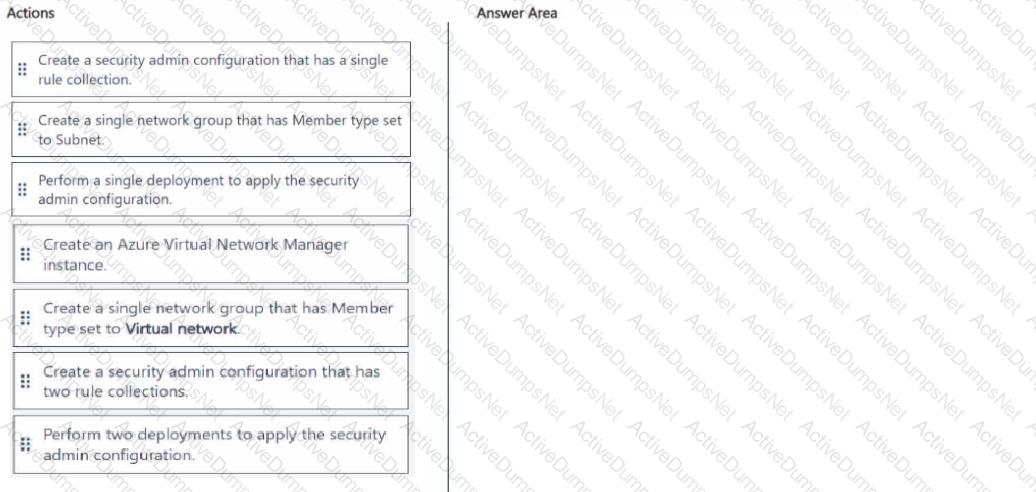
What should you implement to meet the virtual network requirements for the virtual machines that connect to Vnet4 and Vnet5?
For each of the following statements, select Yes if the statement is true. Otherwise, select No.
NOTE: Each correct selection is worth one point.

Which virtual machines can VM1 and VM4 ping successfully? To answer, select the appropriate options in the answer area.
NOTE: Each correct selection is worth one point.

You create NSG10 and NSG11 to meet the network security requirements.
For each of the following statements, select Yes it the statement is true. Otherwise, select No.
NOTE: Each correct selection is worth one point.

You need to meet the network security requirements for the NSG flow logs.
Which type of resource do you need, and how many instances should you create? To answer, select the appropriate options in the answer area.
NOTE: Each correct selection is worth one point.

You are implementing the virtual network requirements for VM Analyze.
What should you include in a custom route that is linked to Subnet2? To answer, select the appropriate options in the answer area.
NOTE: Each correct selection is worth one point.

You are implementing the Virtual network requirements for Vnet6.
What is the minimum number of subnets and service endpoints you should create? To answer, select the appropriate options in the answer area.
NOTE: Each correct selection is worth one point.

For each of the following statements, select Yes if the statement is true. Otherwise, select No.
NOTE: Each correct selection is worth one point.

Task 11
You need to ensure that only hosts on VNET1 can access the slcnage42150372 storage account. The solution must ensure that access occurs over the Azure backbone network.
Task 2
You need to ensure that you can deploy Azure virtual machines to the France Central Azure region. The solution must ensure that virtual machines in the France Central region are in a network segment that has an IP address range of 10.5.1.0/24.
Task 3
You need to ensure that hosts on VNET1 and VNET2 can communicate. The solution must minimize latency between the virtual networks.
You have an on-premises VPN appliance named GW1.
You have an Azure subscription that contains an Azure VPN gateway named VPNGW1. VPNGW1 connects to GW1.
You need to modify the IKEv2 encryption algorithm used by VPNGW1 and GW1.
Which PowerShell cmdlet should you run? To answer, select the appropriate options in the answer area.
NOTE Each correct selection is worth one point.
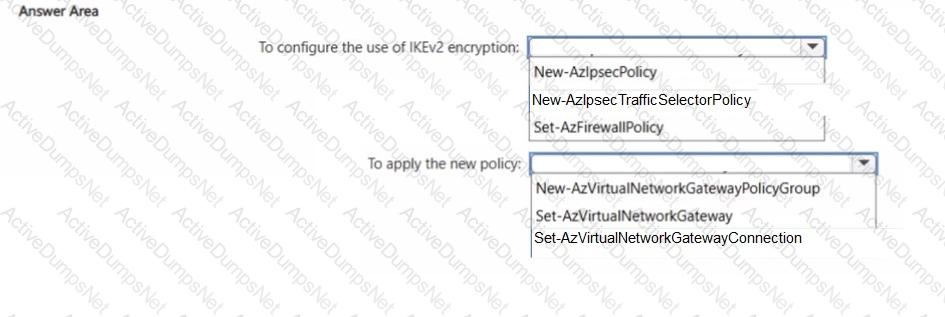
Task 5
You need to archive all the metrics of VNET1 to an existing storage account.
Task 9
You need to ensure that subnet4-3 can accommodate 507 hosts.
Task 11
You are preparing to connect your on-premises network to VNET4 by using a Site-to-Site VPN. The on-premises endpoint of the VPN will be created on a firewall named Firewall 1.
The on-premises network has the following configurations:
• Internal address range: 10.10.0.0/16.
• Firewall 1 internal IP address: 10.10.1.1.
• Firewall1 public IP address: 131.107.50.60.
BGP is NOT used.
You need to create the object that will provide the IP addressing configuration of the on-premises network to the Site-to-Site VPN. You do NOT need to create a virtual network gateway to complete this task.
Task 4
You need to ensure that the owner of VNET3 receives an alert if an administrative operation is performed on the virtual network.
You have an Azure virtual network and an on-premises datacenter that connect by using a Site-to-Site VPN tunnel.
You need to ensure that all traffic from the virtual network to the internet is routed through the datacenter.
How should you complete the PowerShell script to configure forced tunneling? To answer, select the appropriate options in the answer area.
NOTE: Each correct selection is worth one point.
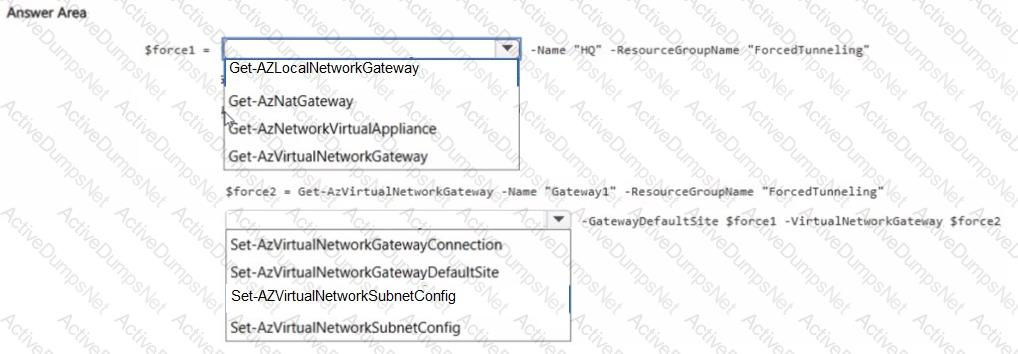
Task 3
You plan to implement an Azure application gateway in the East US Azure region. The application gateway will have Web Application Firewall (WAF) enabled.
You need to create a policy that can be linked to the planned application gateway. The policy must block connections from IP addresses in the 131.107.150.0/24 range. You do NOT need to provision the application gateway to complete this task.
You have an Azure subscription that contains virtual networks, network security groups (NSGs), and virtual machines. You need to perform the following actions:
• Identify unknown traffic between the resources.
• Check the network connectivity between the virtual machines.
What should you use to perform each action? To answer, select the appropriate options in the answer area.
NOTE: Each correct selection is worth one point.
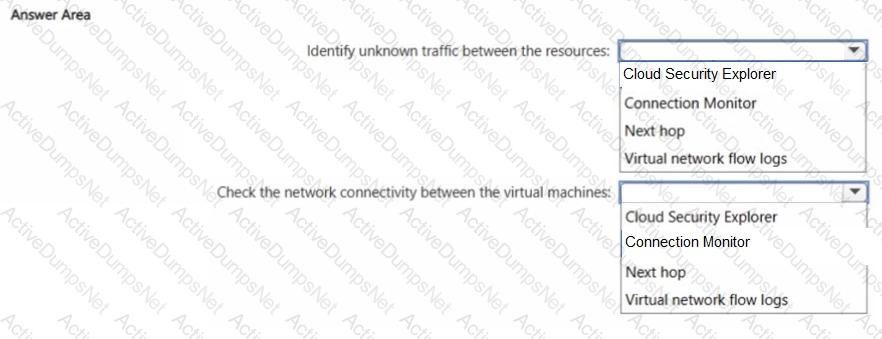
Task 9
You plan to use VNET4 for an Azure API Management implementation.
You need to configure a policy that can be used by an Azure application gateway to protect against known web attack vectors. The policy must only allow requests that originate from IP addresses in Canada. You do NOT need to create the application gateway to complete this task.
Task 7
You plan to deploy 100 virtual machines to subnet4-1. The virtual machines will NOT be assigned a public IP address. The virtual machines will call the same API. which is hosted by a third party. The virtual machines will make more than 10,000 calls per minute to the API.
You need to minimize the risk of SNAT port exhaustion. The solution must minimize administrative effort.
Task 8
You need to ensure that the storage34280945 storage account will only accept connections from hosts on VNET1
Task 6
You have two servers that are each hosted by a separate service provider in New York and Germany. The server hosted in New York is accessible by using a host name of ny.contoso.com. The server hosted in Germany is accessible by using a host name of de.contoso.com.
You need to provide a single host name to access both servers. The solution must ensure that traffic originating from Germany is routed to de contoso.com. All other traffic must be routed to ny.contoso.com.
Task 2
You need to create an Azure Firewall instance named FW1 that meets the following requirements:
• Has an IP address from the address range of 10.1.255.0/24
• Uses a new Premium firewall policy named FW-pohcy1
• Routes traffic directly to the internet
You have an Azure subscription that contains an Azure Front Door named FD1.
You plan to deploy an app named App1 by using Azure App Service. Users will access App1 by using FD1.
You need to provide FD1 with access to Appl. The solution must meet the following requirements:
• Ensure that users can only access App1 by using FD1.
• Ensure that users cannot access App1 directly from the internet.
What should you create for App1?
You have 50 on-premises networks. Each network contains a server that runs Windows Server.
You have an Azure subscription that contains a virtual network named VNet1. VNet1 contains a database server named DB1.
You plan to deploy an app named App1 that will be hosted on the on-premises servers and will connect to DB1 by using Azure Network Adapter.
What should you use to support the Azure Network Adapter connections to VNet1? To answer, select the appropriate options in the answer area.
NOTE: Each correct selection is worth one point.
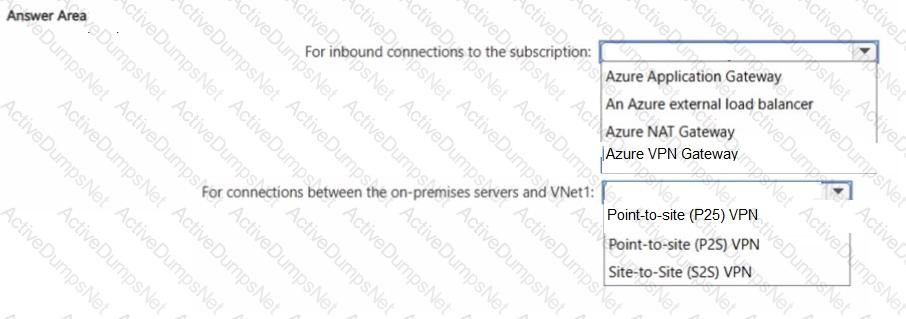
Task 7
You need to ensure that hosts on VNET2 can access hosts on both VNET1 and VNET3. The solution must prevent hosts on VNET1 and VNET3 from communicating through VNET2.